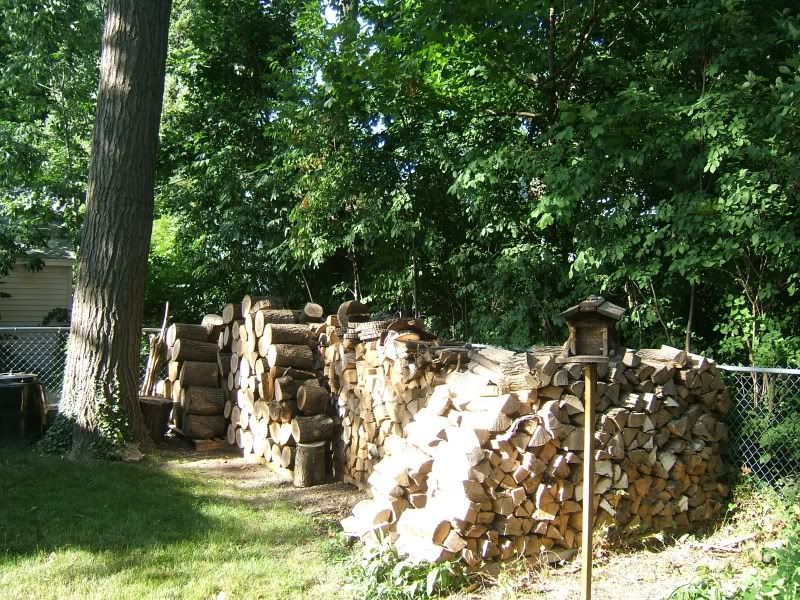This past fall I had an arborist come out and assess the condition of the large (24"+ dbh) oaks on my property. I live in a nearly urban historic area where lots are small and our older trees are a major asset. One of the things that the arborist offered as a suggestion was for me to immediately remove or relocate my firewood stacks, as they are immediately adjacent to a large red oak and within 15-25' of a massive white oak that is struggling already owing to possible chestnut borer problems + extremely tight growing conditions (between house, neighbor's driveway and garage, my garage, etc.). What he did not offer was any good suggestion on how best to minimize the impact of storing stuff adjacent to these trees if removal/relocation of the stuff was not possible.
I do not think that there is any other place where I can store my firewood, so total elimination of the wood pile is a non-option. However, I would like to minimize its impact as much as possible.
The attached picture shows the state of the woodpile as of the mid-summer. I have since added another couple cords behind the chainlink fence immediately behind the tree. That wood is on a mix of plastic and wood pallets, as well as 2x4s elevated 10" off the ground on concrete blocks. The area behind the fence is pea gravel over soil, and is where the dogs do their magic. The area in front of the fence is a mix of grass and gardens. I am considering Round-Uping the some of the grass in front of the fence, mulching and planting a few ornamental plants, and maybe putting a small bench there.
My soil is fairly heavy and clay-rich, and stays wet through the spring before turning to a mudbrick in the summer; I do not routinely water my yard, owing to the very low water pressure that we have in the old neighborhoods in town. I have been core aerating the yard once per year, topdressing with compost a couple times per year, and mulching all my leaves and grass. The area beneath my woodpile as it presently is tends to stay moist throughout the year, and has a much higher number of earthworms than the other parts of the yard. I am going to start working on assessing and improving the fungal and bacterial state of the soil this year, will be installing a water filter on my hose line, and will be discontinuing the use of chemical fertilizer.
I am thinking about redoing my entire wood system using this system in the spring, so there will be 8-10" of elevation for the piles, which would allow improved airflow for the wood, for the soil, and would allow the neighbor cats to get under the pile to police for mice.
With that background, I am looking for suggestions on how best to keep the wood more or less where it is, but to do so in a fashion that minimizes any harm to the trees growing in the immediate vicinity. Thoughts?

I do not think that there is any other place where I can store my firewood, so total elimination of the wood pile is a non-option. However, I would like to minimize its impact as much as possible.
The attached picture shows the state of the woodpile as of the mid-summer. I have since added another couple cords behind the chainlink fence immediately behind the tree. That wood is on a mix of plastic and wood pallets, as well as 2x4s elevated 10" off the ground on concrete blocks. The area behind the fence is pea gravel over soil, and is where the dogs do their magic. The area in front of the fence is a mix of grass and gardens. I am considering Round-Uping the some of the grass in front of the fence, mulching and planting a few ornamental plants, and maybe putting a small bench there.
My soil is fairly heavy and clay-rich, and stays wet through the spring before turning to a mudbrick in the summer; I do not routinely water my yard, owing to the very low water pressure that we have in the old neighborhoods in town. I have been core aerating the yard once per year, topdressing with compost a couple times per year, and mulching all my leaves and grass. The area beneath my woodpile as it presently is tends to stay moist throughout the year, and has a much higher number of earthworms than the other parts of the yard. I am going to start working on assessing and improving the fungal and bacterial state of the soil this year, will be installing a water filter on my hose line, and will be discontinuing the use of chemical fertilizer.
I am thinking about redoing my entire wood system using this system in the spring, so there will be 8-10" of elevation for the piles, which would allow improved airflow for the wood, for the soil, and would allow the neighbor cats to get under the pile to police for mice.
With that background, I am looking for suggestions on how best to keep the wood more or less where it is, but to do so in a fashion that minimizes any harm to the trees growing in the immediate vicinity. Thoughts?
























































